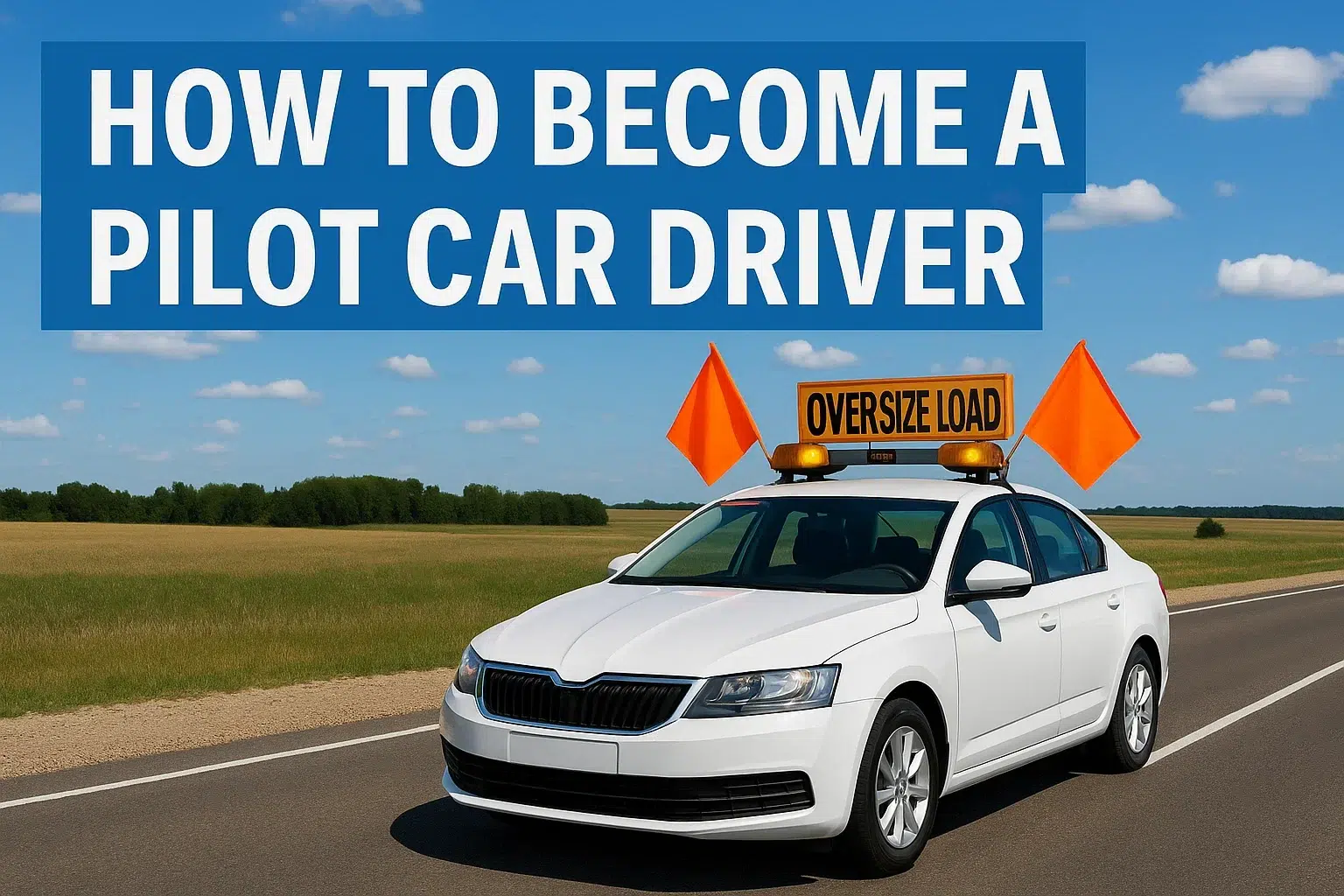Have you ever seen a huge truck carrying heavy cargo containers on the freeway? There is probably a car driving behind or in front of the big truck, with a sign on the car that says “Oversized Load.” The smaller vehicles are called pilot cars and their driver plays an especially important role in the success and safety of the haul. A pilot car driver plays a vital role by diligently navigating complex routes, so their travel is profitable, income is steady, and hours are flexible.
This guide details everything from required equipment to training and schooling, including all the necessary documentation and implementable tips to help you stand out from other pilot car operators.
What is a pilot car driver?
Pilot/escort vehicle operators, or pilot car drivers, mark the boundaries within which oversized and overweight vehicles can operate on public roads. Most modern roads can safely accommodate oversized vehicles due to low traffic levels, but some require escorting vehicles to avoid congestion or accidents.
Pilot car drivers communicate with truck drivers, clear traffic when necessary, and make sure all routes are obstacle-free. They lead and follow loads according to state laws and traffic conditions on the roads.
How to Become a Pilot Car Driver – Step by Step
1. Basic Eligibility Requirements
You are now ready to travel and the prerequisites are as follows:
- Age: All states allow learners age 18 or older. Some companies actually encourage hiring people age 21 or older.
- Driver License: The candidate needs a driver license from their home area. The applicant is not required to have a commercial driver license (CDL), but having one helps.
- Driving History: Agencies and employers prefer people who have few traffic violations and no history of reckless driving.
2. Correct vehicle and car pilot equipment
To become a pilot car driver, their vehicle and equipment must be fit for the job. Every state has its own requirements, but generally you will need:
- Pilot car signage: Convenient “Oversized Load” sign on the rear or roof of the vehicle.
- Lights: Rectangular amber or flashing strobe lights.
- Flags: High visibility red and orange flags that mark the sides of the vehicle.
- Two-way radio: We use CB or VHF radios to communicate with truck drivers.
- Safety gear: Fire extinguisher, reflective safety vest and emergency cones or triangles.
Some states require additional equipment such as height poles depending on the type of cargo being loaded.
3. Complete required training or certification
State regulations vary on whether formal training or certification is required for pilot car drivers. In some states training is not mandatory, yet completing a course is a good sign.
Updated escort placement procedures for both lead and chase vehicles will also be included:
- Changes in emergency strategies
- Elevation pole monitoring
- Traffic control functions: flagging
- Cargo inspection to measure dimensions
- Both state and federal policies
Programs can be done online or in person through private training schools or the NPCA (National Pilot Car Association).
4. Get certified (if required by the state)
In states such as Utah, Colorado, Florida, Washington, and Arizona, pilot operators will need certification. After training, it is common to take a written exam and pay a fee to obtain a certification card.
Always check with the Department of Transportation (DoT) for updated requirements within the state.
5. Understand the limitations
Like any other driving job, pilot car driving also has many state and federal laws associated with it, depending on where you work. Common laws/rules may include the following:
- Prohibited travel hours for the escort (some states do not allow escorts at night)
- Maximum speed limits imposed while escorting
- How much distance the escort must travel from the truck
- Communication protocols that must be followed
- Restrictions on traveling in places where children are present such as schools, cities or when traveling during the holiday season.
Be sure to have an up-to-date guide on the laws, as rules on pilot car laws vary from state to state, especially when crossing state borders.
6. Build a reputation and look for vacancies
After you have the necessary documents, start looking for a position. Working for independent contractors and specialized transportation companies is common in this field.
These can help you find jobs:
- Join pilot car load boards: Websites like LoadPilot and PilotCarLoads.com take the hassle out of searching by allowing companies in need of escort services to post job listings.
- Network with trucking companies: Share contacts with people who manage logistics with low loaders.
- Get insured: Some clients or even states may require you to have an escort vehicle liability insurance policy.
- Advertise yourself: Create a simple website or a dedicated Facebook page where you can explain your qualifications.
Skills and Qualities Needed for Career Advancement
As simple as it may sound, becoming a pilot car driver is much more than just having a flashing beacon and a license. To succeed in this field, one must also have the following skills:
- Attention to details: Be alert to changes in traffic and sudden obstructions, as well as low-height bridges.
- Driver communication: Give precise instructions to truck drivers and sometimes even police officers.
- Patience: Traffic jams, weather delays or aggressive fellow drivers can cause you to lose your composure.
- Strategic planning: A pilot car driver often works on a tight schedule, which can add considerable stress, especially when combined with oversized loads.
- Diagnostic skills: Knowing how to check your vehicle and equipment helps avoid breakdowns while working.
Common Problems in the Position Summary
There are many difficulties in becoming a pilot car driver:
- Long exposure to the weather: Expect to work in rain, snow and even extreme heat or cold.
- Long working hours: Some hauling jobs span multiple states and require overnight travel.
- Responsibility: You’re accountable for preventing accidents and ensuring public safety.
And yes, sometimes you’ll be responsible for dealing with vehicle messes that occur while on the job — like when you have to clean vomit out of a car during a long-distance trip.
Income and Employment Opportunities
In the industry, pilot car drivers are compensated on a per-mile or per-trip basis. Generally, fees for such services range from $1.30 to $2.00 per mile, depending on the geographic area, type of load, and experience of the driver.
For pilot car drivers specifically, a typical gross annual income of $40,000 to $60,000 can be expected, with further income opportunities for more experienced operators. There are also some drivers who may qualify for long-haul routes that are relatively less regulated, controlling super-loads, which enables them to charge premium rates.
Final Thoughts
Becoming a pilot car driver is an ideal profession for individuals who love to travel and take pride in a vital safety role. It’s not just about driving; it’s about responsibility, alertness and teamwork.
Whether you’re escorting a giant wind turbine across state borders or guiding a mobile home through neighborhood streets, you’re part of an essential industry that keeps commercial transportation afloat. By having the right training, equipment, mindset, and strategies, anyone can work toward building a pilot car driver career that is self-fulfilling and gratifying.

I am Tushar Balchandani, founder of Car Info Expert and someone who has been working extensively in the car industry as a car expert for 15 years. My aim is to provide useful truthful and reliable information to the readers based on my real experiences and hands-on experience. From buying tips to maintenance guides, I help readers make confident car-related decisions.

